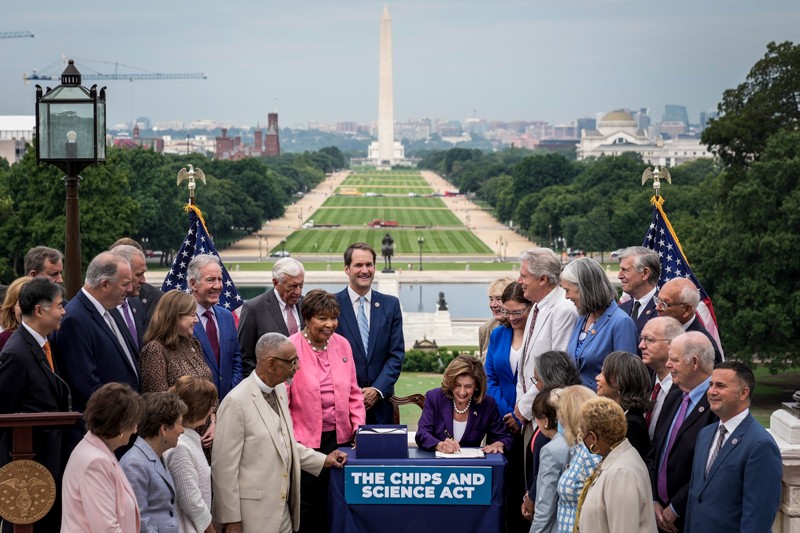The US National Science Foundation and other research agencies could see major infusions of cash, thanks to the US$280-billion CHIPS and Science Act of 2022, which the US Congress passed last week. Two years in the making, this landmark legislation promises one of the biggest funding increases in years for science. But it remains unclear whether Congress will ultimately deliver the money it has pledged.
The legislation centres on boosting domestic manufacturing of semiconductors — or chips — which are crucial for electronics. Currently, the United States produces only 12% of the world’s chips, and Congress has vowed to decrease reliance on other countries to enhance national security and grow the domestic job market.
CHIPS and Science authorizes multibillion-dollar budget increases over the next five years to federal research agencies, including the National Science Foundation (NSF), the Department of Energy (DOE) and the National Institute of Standards and Technology. By investing in these agencies, legislators aim to foster scientific and technological innovation in the United States.
When Congress approved CHIPS and Science, it felt like “a big breath of relief”, says Deborah Altenburg, associate vice-president for research policy and government affairs at the Association of Public and Land-grant Universities in Washington DC. But, she adds, “It’s also only one step.”
Most of the increases represent authorizations to spend a certain amount — not budget appropriations, which provide funding. So each year, Congress will have to decide whether to deliver the promised amounts as it approves appropriations bills that set annual spending for the federal agencies.
Beyond basic research
CHIPS and Science grants the NSF one of the largest monetary expansions it has seen in its 72-year history. The bill authorizes the agency to spend US$81 billion through the 2027 fiscal year, roughly doubling its budget. “The bill shows huge support for not only science, but NSF and our mission,” says Amanda Hallberg Greenwell, head of the Office of Legislative and Public Affairs at the NSF in Alexandria, Virginia.
One-quarter of the grand total will support a division that the agency established this year: the Directorate for Technology, Innovation and Partnerships (TIP). One of eight directorates in the NSF, TIP aims to accelerate the process for bringing certain technologies, such as artificial intelligence and quantum computing, from the laboratory to the market. It marks a commitment to applied science at an agency that has historically focused on basic science.
Ultimately, TIP will help to bridge the “valley of death” that separates basic research and the applications it produces, says Tobin Smith, senior vice-president for science policy and global affairs at the Association of American Universities in Washington DC.
The remaining US$61 billion going to the NSF will support core activities, including growing basic research, funding science education and expanding research opportunities. It will build research capacity through grants at institutions that primarily serve students underrepresented in science and will ramp up investment in academic institutions in states and territories that receive less federal research funding.
Similarly, the DOE is slated to receive nearly US$70 billion, most of which will go to its Office of Science. The funding will support areas of physical sciences — such as fusion and nuclear physics — in national labs, universities and private companies. Like the NSF, the agency will increase its distribution of awards to colleges and universities in geographical locations with minimal federal research funding.
Long road
The path to today’s CHIPS and Science bill began in 2020, when a version was introduced as the Endless Frontier Act. It proposed increasing the NSF budget to US$100 billion over five years to fund a new technology directorate to compete with China.
“Historically, the US has been very strong in basic research, largely driven by the NSF,” says Jacob Feldgoise, a junior fellow at the Carnegie Endowment for International Peace, a think tank in Washington DC. “But in the past couple of decades, we’ve lagged [behind] China when it comes to translating that research into commercial products that make money and drive economic growth.”
But the bill faced criticism, in part for funneling so much money for applied science into the NSF, and some scientists feared that basic research would suffer. In 2021, the Senate settled on a smaller budget increase to the NSF along with money for other agencies.
Earlier this year, the House approved different legislation, the America COMPETES Act, that aimed to enhance domestic science and technology to solve challenges such as climate change and social inequities, as well as increase competitiveness.
The final bill reflects the aims of both pieces of legislation and drew support from both Democrats and Republicans. “This passed on a bipartisan basis in a time when there is not a lot of agreement in Washington,” says Altenburg. “So that is a very big deal.”








More News
Author Correction: Stepwise activation of a metabotropic glutamate receptor – Nature
Changing rainforest to plantations shifts tropical food webs
Streamlined skull helps foxes take a nosedive